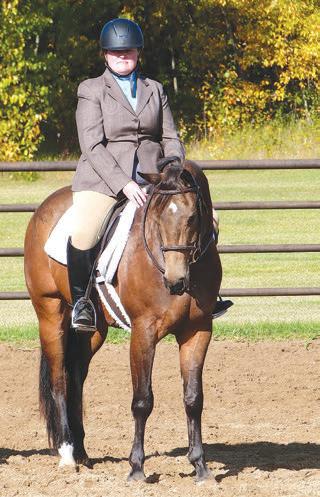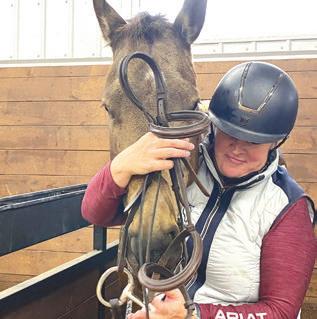
6 minute read
Farm Safety Week


Farm-Related Safety Suggestions
Rosanne Fortier - News Correspondent
Observing Farm Safety is essential. Hence, residents from Vegreville and Area gave these safety tips.
Candice Williams said, “I’m not a farmer personally, but I grew up on one and recently did grain entrapment awareness. So, one safety precaution I learned is if anyone is working around grain bins; do not do so alone, have another person present and have a safety plan.”
Julie Corbett mentioned, “My horse’s name is ‘Lazing Away Sunday’ and I’ve owned him since he was born. He’ll be six in May. I’ve been riding horses off and on for 45 years. I’ll never forget my first pony ride at a fair, I was hooked after that.
I’ve ridden horses primarily as a hobby and have never been into chuckwagons or chariots.
Riding horses either on a trail ride in the mountains or every day in an arena, you should be wearing a helmet and boots with at least a 1-inch heel.

The list of riding safety protocols will change with every rider. I always make sure to take proper care of my tack and equipment and to have spares of tack items on hand. In my trailer, I carry all necessary items for emergencies with my trailer and my horse when we’re heading down the road for a horse show.”
Kim Leitch mentioned, “I grew up on a dairy/mixed farm. The farm has seen a few transitions over the years but cattle have remained a constant.
I have a Bachelor of Science in Agriculture; I worked on a dairy and sheep farm in the UK when I was 18, milking sheep and making cheese. I’ve taught farm safety in schools and worked as an agronomist chemical sales representative.

My husband and I have a small farm in the Mundare area, still in the growing phase. We own 240 acres and rent pasture. We have a small beef herd; pasture-raised turkeys and broilers; layers; and wiener pigs and I have a couple of jerseys I milk as well.
One of the simplest tips is to slow down, don’t rush. That’s when people get careless or forget steps and that’s when accidents happen. Farmers know how to be safe but when it gets busy and they’re tired, safety gets pushed to the side for the sake of time.
I have been to too many classrooms and farms where accidents have happened to families because people were rushing and didn’t take the time.”


Safety Tips While Visiting Farms
Rosanne Fortier - News Correspondence
Ryan and Jessalyn Beniuk own and work at JR Ranch near the Ukrainian Cultural Heritage Village for the past three years.
When asked about their background in farming, Ryan and Jessalyn replied, “Jessalyn grew up on a grain and beef farm just north of Lamont so she has been farming her whole life. Additionally, we still farm with Jessalyn’s family farm: Triple V Simmental Farms LTD.”
When questioned about what JR Ranch has in it, “Our ranch is 50 acres, but we farm a couple thousand acres with Jessalyn's family farm.”
JR Ranch has approximately 80 animals which includes Highland cattle, quarter horses, Kune Kune pigs, chickens, ducks, bunnies, sheep and goats. “We are looking to expand our farm with more variety of animals in the coming year. Jessalyn grew up on a beef farm which has 350 Angus and Simmental cattle currently.”

“A few safety tips we suggest to people visiting farms are:
-Always be seen by the tractor, never assume that the driver has seen you.
-Always ask before going in a pen, you never know if an animal just gave birth and is protective of their baby.
-When feeding tame animals by hand, ensure you keep a flat hand to ensure the animal doesn’t accidentally chomp a finger.
-When unplugging a machine, shut it off completely.
-Never tie a lead rope around you when leading an animal, you never know what will spook an animal and cause them to have a fight-flight response.”


Healthy and Safe Farm Practices
Rosanne Fortier - News Correspondent
Travis and Tracy Semeniuk along with their children Rhett and Judd live a small family-run cattle and grain farm in the Hairy Hill area.
When asked what safety protocols they observe, they replied, “Safety on our farm is a main priority, with the safety of our young children being at the top of the list. Here are a few ways that we ensure that our operation and everyone involved is safe.

As the adults on the farm, we are constantly making sure that we are communicating with each other to make certain that all the adults are aware of where the children are at all times. We do not assume that the children are with one adult or the other, we double and triple-check that everyone is accounted for. Particularly during times when equipment and machinery is driving in and out of the farm yard, or any type of equipment or vehicles are running. We also take every opportunity to communicate with the children about farm safety, speaking about it and role modeling to them.
It is important that at least one person involved in our operation is certified in First Aid and CPR. Our equipment, buildings, and service trucks are stocked with First Aid kits and fire extinguishers and there are people around who are trained to use them.
Mental Health is also another highly prioritized part of our farming operation. We believe that a healthy farmer and crew decreases the risk of a safety incident on the farm. During the especially stressful and busy times of the year, we are cognizant of our mental health needs and the needs of those around us. We prioritize things like eating healthy, drinking lots of water, connecting and communicating about stressful events, doing regular check-ins, and getting appropriate amounts of sleep.”







